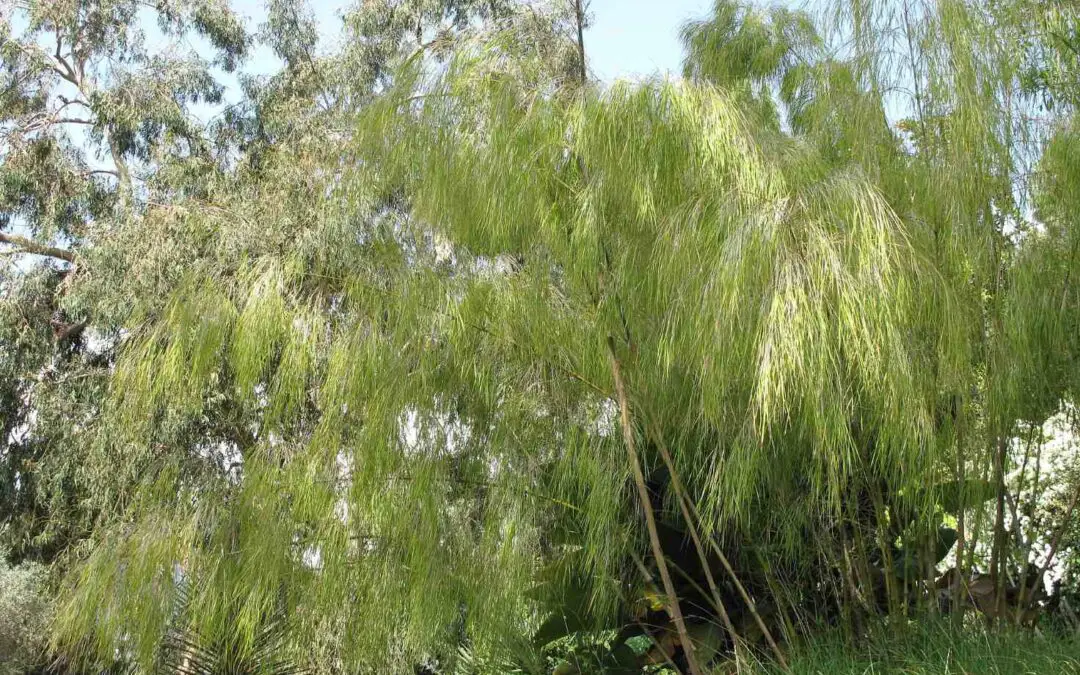Charming Mexico, famous for Mayan pyramids, flourishing cacti and dizzying tequila. And somewhere between Chichen Itza and Margaritavilla, you can also find North America’s greatest selection of indigenous bamboo species. Of the five continents with native bamboo, North America surpasses only Australia. But compared to the U.S. with three species and Canada with zero, Mexico easily dominates the continent for bamboo diversity. And the widest variety of Mexican bamboo belongs to the genus Otatea.
The genus Otatea includes 10 species of clumping bamboo, primarily native to Mexico, as well as Central America. Otateas are tropical bamboos of the Bambuseae tribe, and closely related the neotropical genus Guadau. The best known species is O. acuminata, more often called Mexican Weeping Bamboo, an attractive, ornamental variety with graceful, cascading foliage. The name Otatea comes from the Nahuatl word “otatl”, which means bamboo in the native Aztec language.
Bamboo Genera
This is part of an ongoing series about different types and species of bamboo. To learn more about this fascinating and diverse sub-family of grasses, check out these other articles.
- Running bamboo
- Clumping bamboo
- Genus Bambusa: Paragon of bamboo
- Genus Chimonobambusa
- Genus Fargesia: Clumping bamboo for cold climates
- Genus Gaudua: Neotropical bamboo
- Genus Phyllostachys
- Herbaceous bamboo: Olyreae
Characteristics of genus Otatea
Classified in the Bambuseae tribe within the Bambusoideae subfamily of grasses (Poaceae), Otateas are tropical and subtropical bamboos with a clumping rhizome system. Botanists further divide the Bambuseae tribe into sub-tribes, placing Otatea alongside the genus Guadua in the sub-tribe Guaduinae. The two genera have a similar distribution, running from Mexico to Colombia, but Gauduas are generally giant timber varieties.
Of the tropical bamboos, Otateas are smaller and more compact than most. They tend to have slender culms, no more than 1.5 inches thick, and a manageable height of 20 feet or less. Some dwarf varieties of the genus will only get a few feet tall with pencil thin canes. Their small size makes them ideal candidates for pots and containers.
It’s obvious how these plants earned their nickname, Mexican Weeping Bamboo. The leaves of this genus grow densely but are thin and wispy, and the lissome culms arch downwards as they grow taller. The result is a very graceful and elegant bamboo with cascading foliage that sways pleasantly in the breeze.
Coming from Mexico, these bamboos are best suited for warmer climates. But they are more cold tolerant than many of the giant tropical bamboos, often hardy down to about 20º F. They are also more drought tolerant than most bamboo species.
Distribution of genus Otatea
Of the ten recognized species of Otatea, nine of them are exclusively native to Mexico, from the desert states of Chihuahua and Sonora, all the way down to the subtropical forests and mountains of Chiapas and Oaxaca. Only one species, O. fimbriata, has a wider distribution, from northern Colombia all the way up to Mexico.

Species of Otatea
Otatea acuminata: Easily the most common species for ornamental cultivation, this Mexican Weeping Bamboo is popular in the warmer regions including California and the Deep South. But it can survive mild freezes to about 20º F without incurring frost damage. This variety grows 10-20 feet tall with culms up to 1.5 inches thick. It has a very widespread native habitat covering almost all of Mexico. It’s fairly drought tolerant but looks better with weekly watering.
A popular subspecies is O. acuminata ssp. aztecorum, sometimes listed as a distinct species O. aztecorum. The confusing classification is evident in the dwarf cultivar as well.
Otatea acuminata ssp. aztecorum ‘Chica’: Sometimes listed as Otatea aztecorum ‘Dwarf’, but best known simply as Dwarf Mexican Weeping Bamboo. This diminutive variety only gets about three feet tall and is perfect if you’re looking for a small bamboo to place in a pot. Many of the most popular dwarf bamboos, such as Pleioblastus and Sasa have aggressive, running roots, making them less suitable for containers. Like most dwarf varieties, which naturally grow in the forest understory, ‘Chica’ does better with at least partial shade.
Otatea fimbriata: The most widespread species within the genus, this variety grows from the subtropic highlands of Chiapas, in southern Mexico, through Central America, and down into the northern parts of Colombia. But you are unlikely to find any at your local nursery.
Otatea glauca ‘Mayan Silver’: The silver blue culms make this bamboo particularly beautiful. Foliage is thin and graceful as with other Octateas, but the culms tend to grow upright with less arching, up to about 15-20 feet tall. Native to Chiapas, this subtropical variety is less cold hardy but still relatively drought tolerant.
Other bamboos of Mexico: Genus Olmeca
A small genus of tropical bamboo with only five species, Olmeca also belongs in the sub-tribe Guaduinae, with Guadua and Otatea. Like Otatea, Olmeca is almost unique to Mexico, growing primarily around the Gulf Coast and in the south, but also extending into Honduras. Olmeca reflexa, found growing in lower elevation rainforests, is especially interesting for its soft, fleshy fruits.
Two other important neotropical bamboo genera, Guadua and Chusquea, grow throughout South and Central America. Their distribution extends into Mexico as well. Guadua includes the largest varieties of bamboo in the New World, ideal for building. Chusquea is especially interesting for having solid rather than hollow stems.
Cryptochloa is another bamboo genus common in Mexico. But it is an herbaceous rather than a woody bamboo, more distantly related, in the tribe Olyreae.
Further reading
If you’d like to learn more about the many uses and varieties of bamboo, take a look at some of these related articles.
- Growing Bamboo: The complete how-to guide
- Native bamboos of North America: Arundinaria
- Bamboo in Mexico
- Best bamboo varieties for your garden
- Bamboo anatomy: 9 parts of the bamboo plant
FEATURED PHOTO: Otatea acuminata in the Jardin des Serres de la Madone in Menton, France.

























